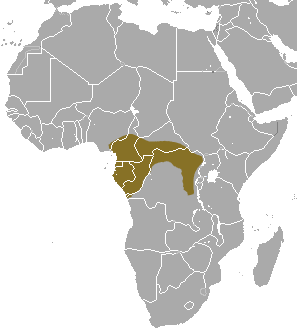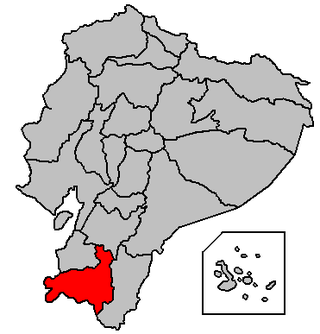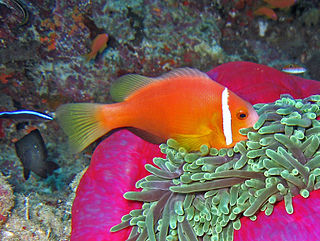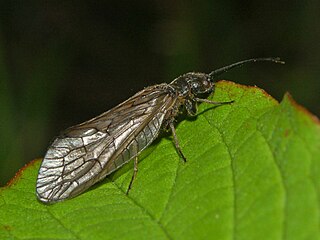
The black-footed ferret, also known as the American polecat or prairie dog hunter, is a species of mustelid native to central North America.

The black-footed cat, also called the small-spotted cat, is the smallest wild cat in Africa, having a head-and-body length of 35–52 cm (14–20 in). Despite its name, only the soles of its feet are black or dark brown. With its bold small spots and stripes on the tawny fur, it is well camouflaged, especially on moonlit nights. It bears black streaks running from the corners of the eyes along the cheeks, and its banded tail has a black tip.

The doucs or douc langurs make up the genus Pygathrix. They are colobine Old World monkeys, native to Southeast Asia, which consists of these 3 species: red-shanked douc, black-shanked douc, and gray-shanked douc.

Heteractis magnifica, also known by the common names magnificent sea anemone or Ritteri anemone, is a species of sea anemone belonging to the Stichodactylidae family native to the Indo-Pacific area.

The black-footed albatross is a large seabird of the albatross family Diomedeidae from the North Pacific. All but 2.5% of the population is found among the Northwestern Hawaiian Islands. It is one of three species of albatross that range in the northern hemisphere, nesting on isolated tropical islands. Unlike many albatrosses, it is dark plumaged.

The bushy-tailed mongoose is a mammal in the family Herpestidae found in central Africa, from southern Kenya to central Mozambique.

The black-footed mongoose is a mongoose species native to Central Africa, where it inhabits deep deciduous forests from eastern Nigeria to the southern Democratic Republic of the Congo. It has been listed as Least Concern on the IUCN Red List since 2008. It is omnivorous and feeds on ants, termites, Orthoptera, small rodents, frogs, lizards and fruits. It is mostly solitary and nocturnal.

Oligoryzomys nigripes, also known as the black-footed colilargo or the black-footed pygmy rice rat, is a rodent in the genus Oligoryzomys of family Cricetidae. Oligoryzomys nigripes is a species that has been further divided into different sister taxa throughout history. It is found in different countries in South America. It is a large species with long ears, dark yellow to dark brown upperparts, sharply delimited from the whitish underparts, and often a pink girdle on the chest. This species of rat spends much of its life among the trees. The karyotype is 2n = 62, FNa = 78–82.

The black-shanked douc is an endangered species of douc found mostly in the forests of Eastern Cambodia, with some smaller populations in Southern Vietnam. The region they are mostly found in is called the Annamite Range, a mountainous area that passes through Cambodia and Vietnam. Its habitat is mostly characterized by evergreen forest in the mountains, in the middle to upper canopy. They move around quadrupedally and by brachiation up in the trees. This species is unique with its coloration among the doucs as it has a bluish face with yellow rings around its eyes a blue scrotum and a pink penis. Like other doucs, this specie has a tail as long as its body and head length. Black-shanked douc have been observed in groups ranging from 3 to 30 indivuals, depending on their habitat. Group tend to have a fission-fusion dynamic that changes with food availability. Their diet varies from dry to wet season. Regardless of the season, their diet consists mostly of leaves, but they have also been found to consume considerable amounts of fruits and flowers during wet season. The species changed conservation status in 2015 from endangered to critically endangered in the IUCN Red List of Endangered Species. This reassessment is due to an increase of the rate of population decline. No global population estimate exists.The majority of the population can be found in Cambodia, with smaller populations in Vietnam. In fact, Wildlife Conservation Society reports a almost 25,000 individuals present in Cambodia's Keo Seima Wildlife Sanctuary, a population that has remained stable over the last decade. The largest populations estimated to be in Vietnam is around 500-600 individuals. The biggest challenges that the black-shanked douc faces in terms of conservation are habitat loss and illegal poaching. Conservation efforts are being made to control illegal poaching and trade in Vietnam by putting laws against hunting and trading threatened species.

Celica is a canton in Loja Province, Ecuador. Its seat is Celica. The canton is located in the west of the province and is bordered by the cantons of Puyango and Paltas in the north, Sozoranga in the east, Macará in the south, and Pindal and Zapotillo in the west. It covers 517.8 km2 at an altitude of 2500 m.

The black-footed shrew is a species of mammal in the family Soricidae. It is endemic to northern and central Sulawesi, Indonesia where it lives on the floor of the tropical forests. The International Union for Conservation of Nature has assessed its conservation status as being of "least concern".

Amphiprion nigripes, is a marine fish belonging to the family Pomacentridae, which includes clownfishes and damselfishes.

Macará Canton is a canton of Ecuador, located in the Loja Province. Its capital is the town of Macará. Its population at the 2001 census was 18,350.
Macara is a genus of moths in the family Megalopygidae.

Sialis is a genus of alderfly belonging to the order Megaloptera family Sialidae.

Agromyza nigripes is a species of fly in the family Agromyzidae. It is found in the Palearctic. The body is black. The thorax and abdomen are shiny. There are 1 + 4 dorsocentral bristles and 7 rows of acrostical bristles. The wing veins are brown, yellow at the base. Long. : 2–3,5 mm. The larva makes serpentine mines in Medicago sativa leaves.

Macara alydda is a moth of the family Megalopygidae. It was described by Herbert Druce in 1887. It is found in Costa Rica and Napo Province, Ecuador. The habitat consists of montane cloud forests.
Macara argentea is a moth of the family Megalopygidae. It was described by Herbert Druce in 1897. It is found in Panama and Ecuador.
Macara purens is a moth of the Megalopygidae family. It was described by Schaus in 1905. It is found in French Guiana.

Orchelimum pulchellum, the handsome meadow katydid, is a species of meadow katydid in the family Tettigoniidae. It is found in North America.
















